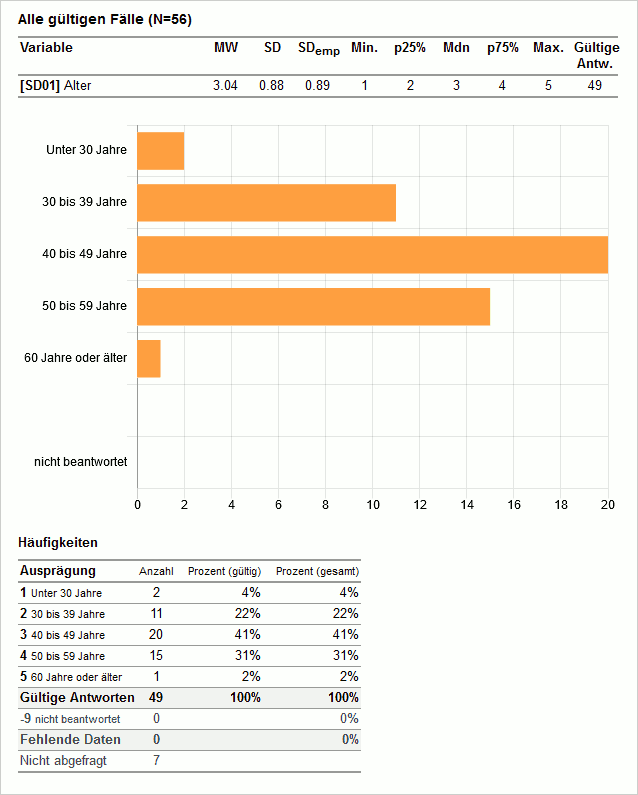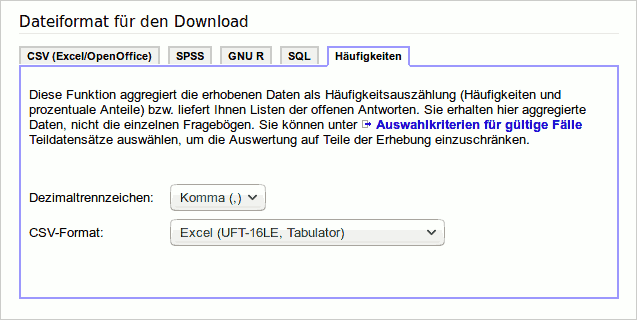- de
- en
Table of Contents
Online Data Analysis
The online data analysis provides charts, frequency distributions, position and scattering measures of the collected data during and after the survey.
Note: The program module for data evaluation is only available on the pro-Server s2survey.net. The use of this server requires the purchase of a prepaid package in the SoSci Survey Shop.
If the module is available for data evaluation, you will see two icons in the upper left-hand corner with which you can switch between the processing and evaluation modes:

After switching to data evaluation mode, select a question in the question catalog on the left to display an evaluation of its variables.
Selection of Valid Cases
To prevent invalid data records (e.g. test data, terminators, persons who only wanted to view the questionnaire once) from being included in the evaluation, you first define selection criteria for valid cases under Collected Data → Filter Criteria for Valid Cases which data records are to be used.
Which criteria these are depends on the specific study. The following criteria can serve as a guide:
- Interview progress
“Records for which the last page of the questionnaire was reached (FINISHED)”
or enter it at Min. edited to page: one page towards the end of the questionnaire (e.g. if only open comments were asked for on the last page) - Interview context (MODE)
“Interview” - Percent of missing answers
10-20% (depending on questionnaire and proportion of mandatory questions) - Interview not started before
Here you can enter the time at which the participants were invited. This reliably excludes test data that may have been generated previously.
Use the Save button  at the top right and check at the bottom of the Summary how many data records will be included in the evaluation.
at the top right and check at the bottom of the Summary how many data records will be included in the evaluation.
Important: These selection criteria are also used if you download the data set of the survey under Collected Data → Download Data.
Definition of Subgroups
You may want to differentiate between different subgroups in the evaluation – for example, different departments in a company or a test and control group.
In evaluation mode, select the menu option Define subgroups for comparisons. Here you can define one or more subgroups to be compared. To do this, enter the following:
- Identification
Any identifier (e.g. “group1”, “production” oder “cg”). The identifier must be entered, but is only used if you are using PHP code for a user-defined result report. - Description
A description for the subgroup (e.g. “Department: Production” or “Control Group”). - Filter condition
Here you enter a formula that defines the cases for the subgroup. You need the variable identifier for this.
Examples of Filter Conditions
If, for example, the department of the participant was queried in the selection question “AB01” and the “Production” department has the answer code 2, then the Filter condition for the “Department” subgroup is:
AB01 == 2
If all participants of the departments with response codes 3 to 8 are to be combined in a subgroup “Small departments” (and if there is no code greater than 8), then the Filter condition is:
AB01 >= 3
If the participants of departments 3 to 5 are to be combined in a subgroup “Accounting and Finance”, then the Filter condition is:
(AB01 >= 3) and (AB01 <= 5)
or
(AB01 == 3) or (AB01 == 4) or (AB01 == 5)
Note: An interview (case) can be assigned to several subgroups. The filter conditions do not have to be mutually exclusive.
View Analyses
In evaluation mode, the question catalog of the project is displayed in the top left-hand corner of the navigation under the heading Evaluation. However, the buttons to create new categories or questions were missing.
Select a question to get an evaluation of the answers. If you have defined subgroups, each subgroup is evaluated individually.

The following values are given in the table with the position and stray dimensions:
- MW – Arithmetic mean (can only be interpreted for interval-scaled variables)
- SD – Statistical standrad deviation (calculated with factor 1/n)
- SDemp – Empirical standard deviation (calculated with factor 1/(n-1))
- Min. – Smallest valid observed value
- p25% – 25% Percentile
- Mdn – Median (50% Percentile)
- p75% – 75% Percentile
- Max. – Largest valid observed value
- Gültige Antw. – Valid answer - number of valid (= not missing) answers
Missing data – i.e. residual options (“do not know”) and codes for “not answered” – are excluded from the calculation of the position and scattering dimensions. Their frequencies can be found in the chart and the frequency table.
Download Frequencies
If you want to download the response frequencies in the data set as a table, select the tab Frequency under Collected Data → Download Data.

Then click the button at the bottom Download Record to download the CSV file. You can open the CSV file as a table after saving, e.g. with Excel or OpenOffice Calc.
Note: The download of the frequency distribution does not yet provide the frequencies differentiated by subgroups.
